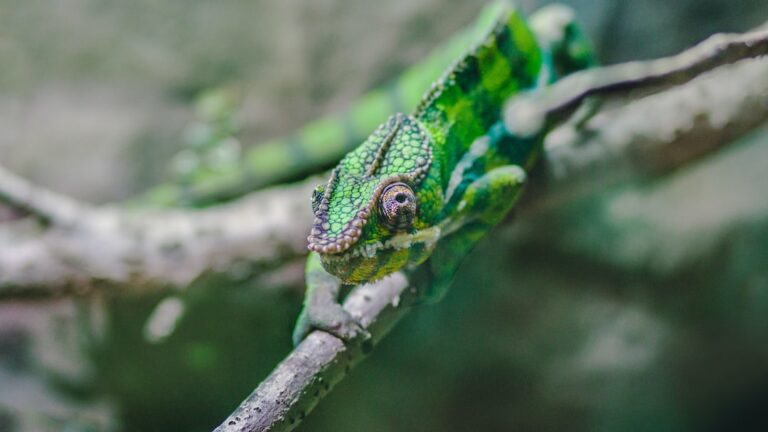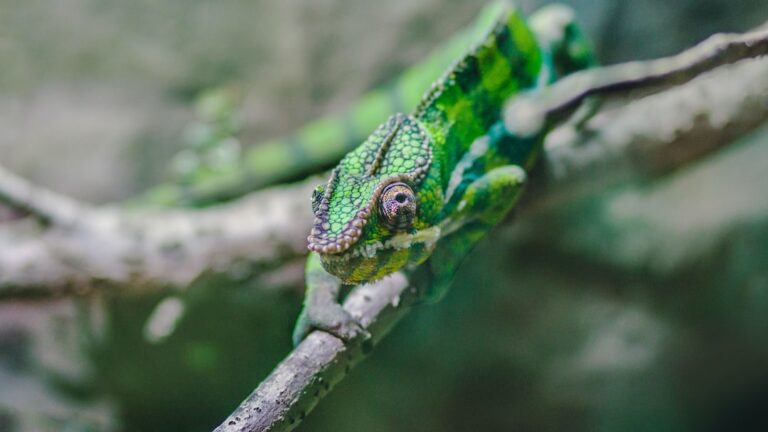Are Chameleons Cuddly?
Chameleons are fascinating creatures that have become increasingly popular as pets in recent years. With their unique ability to change color and their intriguing appearance, it’s no wonder that people are drawn to these reptiles. Chameleons make for interesting and visually appealing pets, but they also require a specific set of care requirements to thrive in captivity.
People choose chameleons as pets for a variety of reasons. Some are attracted to their exotic and beautiful appearance, while others are intrigued by their ability to change color. Chameleons also have a reputation for being low-maintenance pets, as they don’t require daily walks or constant attention like dogs or cats. Additionally, chameleons can be a great choice for individuals who may have allergies to more traditional pets.
Table of Contents
Understanding the nature of chameleons
Chameleons have unique characteristics that set them apart from other reptiles. They are known for their ability to change color, which is primarily used for communication and camouflage purposes. Chameleons have specialized cells in their skin called chromatophores, which contain pigments that can be expanded or contracted to create different colors.
In their natural habitat, chameleons are found in tropical and subtropical regions, such as rainforests and deserts. They are arboreal creatures, meaning they spend most of their time in trees and bushes. Chameleons have adapted to this lifestyle by developing specialized feet that allow them to grip onto branches and leaves.
These factors can affect a chameleon’s cuddliness. Chameleons are not naturally inclined to seek out physical contact with humans or other animals. Their behavior in the wild is typically solitary, and they prefer to keep their distance from potential threats. This instinctual behavior can make them less likely to enjoy being held or cuddled.
Do chameleons like to be held?
Chameleons have a unique response to handling that can vary from individual to individual. Some chameleons may tolerate being held, while others may become stressed or agitated. It’s important to understand that chameleons are not domesticated animals like dogs or cats, and their natural instincts may not align with our desire for physical affection.
Several factors can influence a chameleon’s comfort level with handling. These include their age, species, and individual personality. Younger chameleons may be more skittish and less accustomed to human interaction, while older chameleons may be more tolerant of handling. Additionally, different species of chameleons have different temperaments and may have varying levels of tolerance for being held.
To determine if your chameleon is comfortable being held, it’s important to observe their body language. Signs of stress or discomfort can include hissing, puffing up their body, or changing color in a way that indicates agitation. If your chameleon displays these behaviors, it’s best to respect their boundaries and avoid handling them.
The importance of handling chameleons properly
Mishandling chameleons can pose risks to both the reptile and the handler. Chameleons have delicate bodies and can easily become injured if they are dropped or squeezed too tightly. Additionally, excessive handling can cause stress and anxiety for the chameleon, which can lead to health issues.
When handling a chameleon, it’s important to do so safely and gently. Always support their body with both hands and avoid squeezing or applying pressure. It’s also important to wash your hands before and after handling a chameleon to prevent the spread of bacteria or other contaminants.
Proper handling can have benefits for both the chameleon and their owner. Regular, gentle handling can help acclimate a chameleon to human interaction and reduce their stress levels. It can also provide an opportunity for the owner to observe their chameleon’s health and behavior up close.
Factors that affect chameleons’ cuddliness
Several factors can influence a chameleon’s cuddliness. Age and gender can play a role, as younger chameleons may be more skittish and less accustomed to handling, while older chameleons may be more tolerant. Additionally, different species of chameleons have different temperaments and may have varying levels of tolerance for being held.
Individual personality also plays a significant role in a chameleon’s cuddliness. Just like humans, chameleons have unique personalities and preferences. Some chameleons may enjoy being held and seek out physical contact, while others may prefer to keep their distance. It’s important to respect your chameleon’s individual preferences and not force physical contact if they are not comfortable with it.
It’s also worth noting that chameleons are not typically considered “cuddly” pets in the traditional sense. They are not domesticated animals like dogs or cats, and their natural instincts may not align with our desire for physical affection. While some chameleons may tolerate being held, it’s important to remember that their primary needs are for a suitable habitat, proper nutrition, and a stress-free environment.
Can chameleons bond with their owners?
Chameleons have the capacity to form bonds with their owners, although these bonds may be different from those formed with more traditional pets. Chameleons are intelligent creatures that can recognize their owners and become accustomed to their presence.
Building a bond with your chameleon takes time and patience. It’s important to establish trust by providing a safe and comfortable environment for your pet. Spend time near the enclosure, talking softly to your chameleon and offering treats or food from your hand. Over time, your chameleon may become more comfortable with your presence and may even approach you willingly.
Bonding with your chameleon can have several benefits. It can help reduce their stress levels and make them more comfortable in their environment. It can also provide an opportunity for you to observe their behavior and health more closely. Additionally, a bonded chameleon may be more receptive to handling and may tolerate it better than a chameleon that has not formed a bond with its owner.
Tips for creating a comfortable environment for chameleons
Creating a comfortable environment for your chameleon is essential for their well-being and can also contribute to their overall cuddliness. Proper enclosure setup is crucial, as chameleons require specific conditions to thrive. This includes providing a spacious enclosure with plenty of climbing branches and foliage for them to hide and explore.
Temperature and humidity requirements are also important considerations. Chameleons are ectothermic animals, meaning they rely on external heat sources to regulate their body temperature. It’s important to provide a temperature gradient within the enclosure, with a warm basking spot and cooler areas for the chameleon to retreat to.
Proper lighting is also crucial for chameleons, as they require UVB light to synthesize vitamin D3 and maintain proper calcium metabolism. Full-spectrum UVB bulbs should be used in conjunction with a heat source to provide the necessary lighting requirements.
Feeding recommendations for chameleons include a diet of live insects such as crickets, mealworms, and waxworms. It’s important to provide a varied diet to ensure proper nutrition. Gut-loading the insects with nutritious foods before feeding them to the chameleon can also help ensure they receive the necessary vitamins and minerals.
How to build trust with your pet chameleon
Building trust with your pet chameleon is essential for their well-being and can also contribute to their overall cuddliness. Trust is important for handling and bonding with your chameleon, as it helps reduce their stress levels and makes them more comfortable in their environment.
To establish trust with your chameleon, it’s important to start by providing a safe and comfortable environment. This includes ensuring their enclosure is set up properly and meets their specific needs. Spend time near the enclosure, talking softly to your chameleon and offering treats or food from your hand. This will help them associate your presence with positive experiences.
It’s also important to handle your chameleon gently and respectfully. Avoid sudden movements or loud noises that may startle them. Start by simply placing your hand near them and allowing them to approach you at their own pace. Over time, they may become more comfortable with your presence and may even willingly climb onto your hand.
Building trust with your chameleon takes time and patience. It’s important to respect their boundaries and not force physical contact if they are not comfortable with it. By providing a safe and comfortable environment and handling them gently, you can help build a trusting relationship with your chameleon.
Common misconceptions about chameleons and cuddliness
There are several common misconceptions about chameleons and their cuddliness that are important to address. One misconception is that all chameleons enjoy being held or cuddled. While some chameleons may tolerate handling, it’s important to remember that they are not domesticated animals like dogs or cats, and their natural instincts may not align with our desire for physical affection.
Another misconception is that chameleons are aggressive or dangerous pets. While it’s true that chameleons can become stressed or agitated if mishandled or if their boundaries are not respected, they are generally not aggressive animals. With proper care and handling, chameleons can be docile and make for interesting and visually appealing pets.
It’s also worth noting that chameleons are not typically considered “cuddly” pets in the traditional sense. They are not social animals and do not seek out physical contact like dogs or cats. While some chameleons may tolerate being held, their primary needs are for a suitable habitat, proper nutrition, and a stress-free environment.
The truth about chameleons and their cuddliness
In conclusion, chameleons can make for fascinating and visually appealing pets. While they may not be traditionally considered “cuddly” pets, they have their own unique charm and can form bonds with their owners. Understanding the nature of chameleons and providing them with a suitable environment and proper care is essential for their well-being.
Chameleons have specific care requirements that must be met in order for them to thrive in captivity. This includes providing a spacious enclosure with plenty of climbing branches and foliage, maintaining proper temperature and humidity levels, and providing appropriate lighting and nutrition.
Handling chameleons should be done with care and respect, as mishandling can pose risks to both the reptile and the handler. Building trust with your chameleon takes time and patience, but can result in a more comfortable and enjoyable experience for both you and your pet.
It’s important to dispel common misconceptions about chameleons and their cuddliness. While some chameleons may tolerate being held, it’s important to remember that they are not domesticated animals like dogs or cats, and their natural instincts may not align with our desire for physical affection.
Overall, chameleons can be rewarding pets for those who are willing to put in the time and effort to understand their unique needs. With proper care, handling, and respect for their boundaries, chameleons can thrive in captivity and provide their owners with years of enjoyment.
If you’re interested in learning more about reptiles, you might also enjoy reading the article “Are Turtles Dumb?” on Reptile Friend. This fascinating piece explores the intelligence of turtles and challenges common misconceptions about their cognitive abilities. Discover the surprising ways in which turtles navigate their environment and adapt to various situations. Read more







